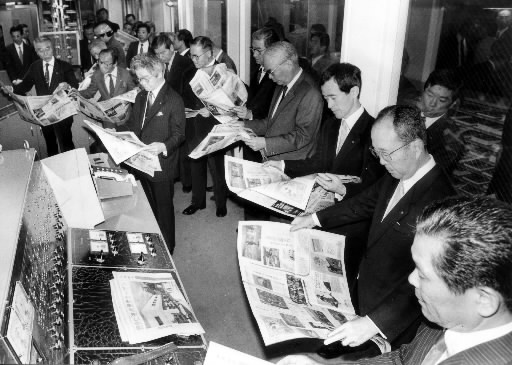Trust: The Memoirs of Akira Yamamoto, Part 24
Oct. 29, 2012
Part 24: Strategies for the future
Developing new businesses around the newspaper
On April 21, 1984 the Chugoku Shimbun Joho Bunka Center (whose president was Akira Yamamoto) submitted an application to the Chugoku Bureau of Telecommunications to set up cable television broadcasting facilities and start operations, and the application was accepted.
Urban cable TV was attracting attention as a practical form of “new media,” and this was the first launch of such broadcasts in Japan. But wiring Hiroshima’s business district for cable TV was more difficult than we had thought it would be. We had to decide which streets to install cable along and which utility poles to hook up to. The managers of some office buildings were reluctant to have their properties wired for cable. Branch and field offices had to get permission from the head office. Under those circumstances it was not easy to get 100 member companies.
A video of remarks by me as president was made in the studio of Chugoku Cable Television (now Fureai Channel), which was set up on the ninth floor of the Chugoku Shimbun building. The script was written out vertically on a big roll of paper, and I read it as it was unrolled. All went well, and I didn’t make any bloopers. The video was broadcast starting on the morning of July 10.
Approximately 20 km of coaxial cable was installed, and broadcasting of local programming began on Channel 3, one of 27 available channels. With revisions to the Telecommunications Business Act in 1985, trading companies and banks entered the cable TV and data service businesses, which also heralded the arrival of “new media business.”
We did a broadcast that would have been unthinkable for a television station in the past. Gov. Toranosuke Takeshita talked for an hour at the Chugoku Keizai Club about his visit to Szechuan Province in China. We broadcast that uninterrupted. The screen was black, but the sound was clear. The engineers from RCC Broadcasting who participated were surprised, but they were impressed by our unusual method.
The following year we introduced the Character and Pattern Access Information Network (Captain) System (a system created by NTT for the transmission of characters and images over phone lines) and began offering it to ordinary homes. Some people questioned why we were moving so fast. I didn’t think that new media could ever replace newspapers either, but I felt certain they would be linked in the future and I took action in that belief.
The Chugoku Shimbun won the Japan Newspaper Publishers and Editors Association (NSK) Prize for fiscal 1986 (in the management and operations division) for its “development of a local information network.” The citation noted that the company had “put new media to practical use, and its philosophy of gradually becoming more comprehensive shows a great deal of inventiveness.”
At lunch after the meeting of the NSK Prize selection committee, Kazuo Ichiriki, (chairman of Kahoku Shinposha) congratulated me. “This must be the first time in the history of the prize that a father selected work done by his son (Jiro Yamamoto, then senior managing director, now chairman of the company) and it won.” I said, “There was some opposition to this business within the company, but I couldn’t be happier about receiving this award.” Yosaji Kobayashi, chairman of the NSK (president of the Yomiuri Shimbun), nodded as if he understood what I meant.
In 1987 the company again received the NSK Prize in the management and operations division for “the creation and development of the Flower Festival.” The association unanimously praised the effort saying, “Taking into account the desire of the citizens for peace and making the festival a non-profit operation is novel and highly inventive.” Jiro spoke eloquently on the aim of the festival to the selection committee. On his way back to Hiroshima, he had gotten off the train in Kyoto and visited the charnel house at Nishi Hongan-ji Temple, where the ashes of his brother Jiro (who proposed the festival) are housed, and told him about the award.
Atsuo Asano, 80, participated in the new media business and served as manager of the Media Division that the Chugoku Shimbun set up in 1988. “Looking back from this age of the Internet, our efforts were trial and error. But they led to the development of various types of information transmission and services for our readers revolving around the newspaper.” The Fureai Channel currently broadcasts on 67 channels to 350,000 households in Hiroshima and three other communities.
(Originally published on October 26, 2012)








